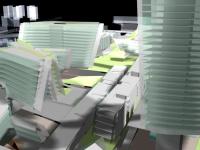RECLAIMING THE CITY- URBAN NEXUS 2020 {2001-2003}; Design & Research: Suprio Bhattacharjee / 3D renderings: Neville Fernandes; PUBLICATION: `Archiprix International 2001/2003`, O1Opubishers, NAi, Rotterdam, 2004; BRIEF: Sustainable Infrastructure and Growth Model for dense cities such as Mumbai. Station redeveloped with speculative development, retail, a hotel, cultural facilities {two 500-seater auditoria and a 1000-seat concert hall} along with a multiplex cinema with 5 screens. Project involved the use of green roofs over concrete slabs acting as heat sinks cooling the station below, self-shading strategy in the orientation of towers, bio-climatic design principles for the office towers such as east-west orientation, narrow floor plates {average width 12-14m} to maximize daylight penetration and natural ventilation, use of terracotta and GRC jaalis on the south façade of office towers and planted terraces {sky gardens} on sunward sides.; ISSUES: This prospective global city faces crises at multitude levels. Placeless objects in the name of new age architecture are slowly obliterating a sense of cohesive social structure and unique scale specific to each place and community – does the city loose its layered identity in favour of a place-less plastic imagery? Besides, the city needs to address other issues important for its survival – such as sustainable models of growth, the issue of sprawl; and the indiscriminate destruction of verdant land and natural eco-systems for development purposes when brownfield and greyfield sites are more than available. ; THE CITY AS A HYPER-NETWORKED ENTITY: The premise of this project works on the reality that the city functions as a series of node-places where each railway station becomes the hub of each suburb – since it is most accessible. Going on the dictum of maximum density at the place of maximum connectivity, a city structure for Bombay can be envisaged wherein each suburb shall act as a self-sustaining fragment of a larger urban system – connected by a web of non-linear mass movement system, creating a hyper-networked entity. This would encourage and initiate balanced growth within the city and would ensure a sustainable vision for the city into the future.; ARCHITECTURE AS BEING EMBEDDED: URBAN NEXUS – RECLAIMING THE CITY – PROJECT FOR THE ANDHERI INTERMODAL: Large-scale architectural interventions can evolve from the forces that inhabit the site to become extensions of the city, embedding themselves in diverse immediate conditions while being differentially scaled so that each part responds to a specific and changing urban situation – pieces of cityscape rather than an imposed monolith. About a million and a half people use the Andheri Station Precinct every day. In addition to being a center of small-scale industry and a prominent dormitory suburb, andheri has become the unofficial hub of the service industry in the city, a fact aided by its strategic geographic centrality, its proximity to the international airport and a growing hotel and business district. This project was conceived in anticipation of such a growth. Contradicting the official stand of the city government, it proposed an intensification of the urban experience at the station through a densely layered spatial organisation – all integrated into one seamless whole. The station site was imagined as a crossing point or a ‘nexus’ in a city traditionally divided into inaccessible easts and wests by broad swathes of railway tracks cutting across it. The project would need to suture these deep gashes - healing the cityscape and reclaiming precious land lost. Conceptually, it begins with stretching across a membrane of connectivity forming a fluid public space allowing for visual clarity and easy orientation. This membrane becomes the crossing or nexus accommodating a number of super-imposed built forms hovering above. These would be of two kinds – low-scaled linear multi-use buildings oriented N-S along courtyard spines t
2001
2003
`reclaiming the city: urban nexus 2020` : the andheri intermodal, mumbai, india by suprio bhattacharjee in India won the WA Award Cycle 4. Please find below the WA Award poster for this project.

Downloaded 247 times.
Favorited 2 times










.jpg)